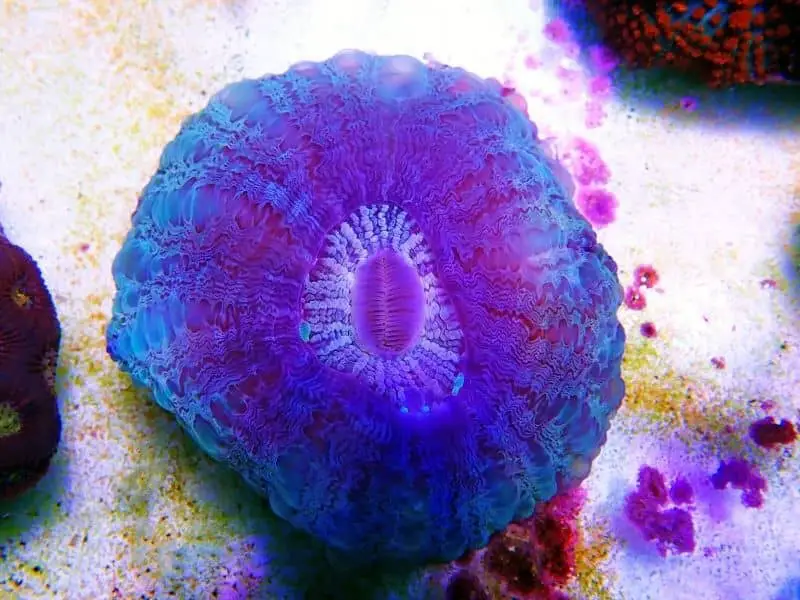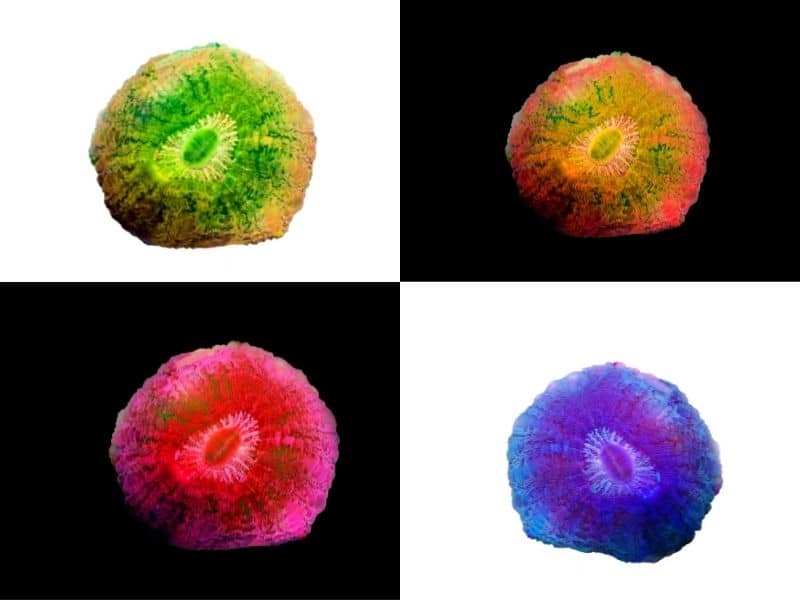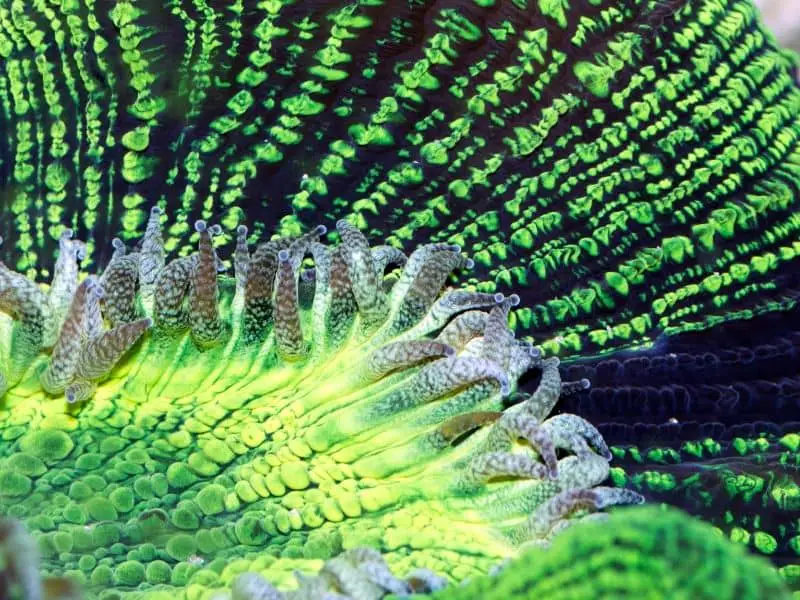Acanthophyllia Coral is an asset to your reef aquarium. So, if you can invest a bit of your love and time, they will provide stunning and vibrant colors to reef aquariums. If you maintain proper water quality and feed them in a proper way, it is easy to care for your Acanthophyllia Corals.

Quick Overview
Jump To
- 1 Quick Overview
- 2 They Are Commonly Found In,
- 3 One Look Care Guide
- 4 Appearance
- 5 Acanthophyllia Coral Colours And Types
- 6 Tank Requirements
- 7 How To Place Acanthophyllia Coral In A Tank
- 8 How To Frag Or Propagate Them
- 9 How Fast Does Acanthophyllia Coral Grow?
- 10 What Does Acanthophyllia Coral Eat?
- 11 Predators of Acanthophyllia Coral
- 12 Why is Acanthophyllia Coral dying?
- 13 FAQ
- 14 Source
Acanthophyllia Coral is commonly known as Meat coral and Doughnut coral. They are Large polyp stones. Acanthophyllia Coral needs a moderate care level. In addition, they can keep them in a wide range of tank conditions. The meat coral is suitable for both beginners and advanced reef aquarists. Acanthophyllia Coral is some of the most expensive ones in the coral industry. This beautiful coral species comes with wonderful colors and patterns. At present they are available in a variety of colors from pastel to bright and translucent. Their colors are as vibrant and iridescent as a rainbow.
They Are Commonly Found In,
- Australia – Species in Australia come in a greenish-blue mint chocolate chip appearance.
- Indonesia- species in Indonesia come in red and blue colors.
Normally, they are semi-aggressive coral species. But when you rear them in your tank, you should provide enough space between your Acanthophyllia Coral and other corals. Because they are showing aggressive behavior when they do not have enough room to grow. Acanthophyllia Coral can grow up to twice its starting size. In addition, you should keep them in medium lighting conditions and low water movement. Also, to generate a happy and healthy Acanthophyllia Coral, you should consider the calcium, strontium, and other trace elements of the water in your reef aquarium. Furthermore, they like to eat meaty foods.
One Look Care Guide
| Scientific name | Acanthophyllia deshayesiana |
| Common name | Acanthophyllia Coral, meat coral, donut coral |
| Care Level | Moderate |
| Reef Compatible | Reef safe |
| Native to | Australia, Indonesia |
| Type (soft or hard coral) | hard |
| Color | Rainbow colors including Orange Blue Green Red |
| Tank size | 50 gallons (190L) |
| Preferred temperature | 72-78 Fahrenheit |
| Water parameters | Alkalinity – 8-12 dKH Calcium- 425 ppm Magnesium – 1350ppm pH level – 8.1-8.4 Phosphate – below 10ppm Nitrates – zero (0 ppm) Nitrites- zero (0 ppm) Ammonia- zero (0 ppm) |
| Preferred salinity | 1.023-1.025 specific gravity |
| Size | The maximum size is 4 to 5 inches |
| Growth rate | No exact growth rate |
| Temperament | Semi-aggressive |
| Recommended tank mates | You can keep them with reef safe species |
| Preferred food | Shrimps, LCP pellets, Seafood and plankton |
| Feeding frequency | Once per week |
| Propagation | Cannot propagate in captivity Propagate by sexually or asexually |
Appearance
Acanthophyllia Coral is a single polyp. They are round in shape. This amazing and expensive coral type comes in a variety of colors. Their colors are as vibrant and iridescent as a rainbow. These are;
- Green
- Purple
- Orange
- Red
- Blue
When considering the appearance of Acanthophyllia Corals, is similar to the appearance of,
- Scolymia or scoly coral
- Homophyllia sp.
- Cynarina sp.
Acanthophyllia Corals are large polyp stony. They can grow up to twice their starting size.
Acanthophyllia Coral Colours And Types
There are many Acanthophyllia varieties based on their colors. They can be kept in the same water condition. Those are,

Holographic Acanthophyllia
This Acanthophyllia type has a beautiful appearance with its multicolored spots.
Rainbow Acanthophyllia
This Acanthophyllia type is decorated with rainbow colors.
Fluorescent Acanthophyllia
This Acanthophyllia variety makes mind-blowing color patterns under fluorescent lighting conditions.
Green Center Red Acanthophyllia
This type is decorated with green and red colors.
Neon Green Acanthophyllia
Among types of Acanthophyllia corals neon green color is one of high-colors Acanthophyllia.
Aussie Green Acanthophyllia
They have a color mixture of brown, green, and pink.
Red Acanthophyllia
The red color is the dominant of this Acanthophyllia type.
Tank Requirements
When you rear any coral including Acanthophyllia Coral, you should highly consider the tank setup and water quality parameters.
Size Of The Tank
- If Acanthophyllia Coral have not enough space, they will show aggressive behaviors
- At least you should have a 50-gallon (190L) tank
- But if you have the ability to arrange larger than 50-gallon, it is better
- You should consider this factor not only for Acanthophyllia Coral but also for all reef creatures. Because overcrowding is not a good thing
Water Quality
When considering water chemistry, Calcium Content Magnesium Content & Alkalinity are the three major chemical parameters. These three chemical parameters help the growth of the skeleton of Acanthophyllia Coral.
| Parameter | Ideal Range |
| Calcium | 425 ppm |
| Alkalinity | 8-12 dKH |
| Magnesium | 1350 ppm |
| pH level | 8.1-8.4 |
| Salinity | 1.023-1.025 Specific gravity |
| Temperature | 72-78 Fahrenheit |
Ammonia, Nitrate, Nitrite and Phosphate level
- Phosphate and nitrates are the by-products of fish waste and uneaten foods. They can harm your corals as well as other creatures in your tank.
- You should keep the Ammonia, Nitrate, Nitrite and Phosphate levels at zero.
- If these parameters exceed 10ppm, they have lethal effects on coral and fish.
Flow Rate
It is recommended for low to medium water flow. Above all, if you provide a strong laminar flow to your Acanthophyllia Coral, the skeleton starts to poke through the flesh. Because they are fleshy corals. Also, a low flow rate helps them to feed easily. Therefore, you should place them in a low to moderate flow area.
Lighting
You should keep them in low to moderate lighting conditions. If you keep them in a high lighting condition, there is a risk of bleaching out. Generally, they do not appreciate the high lighting conditions.
Important:
- Low light conditions : between 30-50 PAR (Photosynthetically Active Radiation)
- Medium-light conditions : between 50-150 PAR
- The high light conditions : over 150 PAR

How To Place Acanthophyllia Coral In A Tank
Here, you should choose an adequate space to grow them in your tank. Choose a place at the bottom of your tank. If the aquarium does not have enough space, you can place them in a middle level in your tank. They are happy to stay on the sand bed. Because it helps them to spread. Make sure, the place where you choose to place Acanthophyllia Coral has a low to moderate flow rate and lighting conditions. There is a probability to cut the fleshy part of the coral from this sharp skeleton. The skeleton of Acanthophyllia Coral is very sharp. Therefore, you should have great care when you handle them.
Follow The Following Guidelines When You Handle Acanthophyllia Coral.
- you should wear protective gloves
- you can use waterproof rubber, bandages, or latex gloves if you have some injuries or allergies
- Wearing protective eyewear is also an added advantage
- After handling, you should wash your hands with hot water for at least twenty seconds
- Do not forget to scrub your hands properly.
- If you already have skin injuries such as cuts, irritations, or sores, it is better to avoid coral handling until it will heal.
Related Bubble Tip Anemone (Entacmaea quadricolor) 9 Important Care Facts
Related Rock Flower Anemone | Beautiful Rock Flowers To Your Aquarium
Also see Sand Sifting Starfish (Astropecten polycanthus) Care, Must Know Points
How To Frag Or Propagate Them
You cannot frag or propagate Acanthophyllia Coral in captivity. This coral type does not like to survive in such boredom. Therefore, if you need a happy, healthy coral, do not try to frag them. It will shorten their lives. The best thing that you can do is, wait until the frag propagates naturally sexually or asexually. When the right time comes, they will reproduce.
To encourage Acanthophyllia Coral propagation, Maintain the water parameters properly Feed Acanthophyllia Coral well & Care them. Then your Acanthophyllia Coral will create buds, and reproduce in a healthy and natural way.
How Fast Does Acanthophyllia Coral Grow?
There is no exact growth rate. They grow two times larger than their normal size during their lifespan.
You Should Care For Them Well By:
- Provide enough quality foods
- Maintain water conditions at the preferable level
- Prevent stressful factors from Acanthophyllia Corals
You can generate healthy and well-grown Acanthophyllia Corals in your reef aquarium.
What Does Acanthophyllia Coral Eat?
Acanthophyllia Coral is photosynthetic. But spot feeding plays a major role.
Feeding helps them;
- To grow properly
- Enhance their color
- Improve their health.
This coral type needs food supplements to empower the photosynthesis of the microorganisms in Acanthophyllia Coral’s tissues. Then, they will show their happiness with their vibrant looks. Therefore, if you do not provide food, they will not be happy. You can provide the following foods to them.
- Shrimps
- Plankton
- Seafood
- LPS pellets
- liquid food
How To Feed Them
- Before you provide the foods like shrimp, you should chop and mix them with the water in the aquarium.
- spray or sprinkle that liquid food right over the polyp of the coral.
- They will grab and slurp the foods themselves
The important fact is,
When your tank water is warm, it will faster Acanthophyllia Coral’s metabolism.
Feeding Frequency
You can feed them once a week. It can be varied with the size and age of your Acanthophyllia Corals.
After Feeding
After feeding your Acanthophyllia Corals, you should remove the uneaten foods from your tank. Because it reduces the water quality of your reef aquarium. Uneaten foods deteriorate and reduce the water quality of an aquarium. Release the by-products such as;
- Ammonia
- Nitrate
- Nitrites
These can affect your marine creatures including corals and fish species.
Predators of Acanthophyllia Coral
Corals including Acanthophyllia Corals are vulnerable to predators. There is a possibility to prey on the soft inner tissues of polyps in some fish species such as,
- Marine worms
- Barnacles
- Crabs
- Sea stars &
- Snails
The following fish and non-fish species are not safe to keep with your Acanthophyllia Corals.
- Barracuda
- Triggerfish
- Parrotfish
- Fireworks
- Nudibranchs
- Whelks
- Crown-of-thorns starfish
- Pyramid snail
- Vermetid snail
- Keyhole limpet
When you select fish species or non-fish species for your reef tank you should aware of each species. Above all, their behavior can be varied with each coral.
Following species can be kept with Acanthophyllia because they are reef safe.
- Coral beauty angelfish
- Fisher’s angelfish
- Flame angelfish
- Lemonpeel angelfish
- Masked angelfish
- Multicolor angelfish
- Orange-lined or Eibl’s angelfish
- Flesh percula clownfish
- True percula clownfish
- Tomato clownfish
- Clarkii clownfish
- Fire, red and black or cinnamon clownfish
- Pink skunk clownfish
- Saddleback clownfish
- Green mandarinfish
- Psychedelic mandarinefish
- Small gobies
- Basslets
- Firefish
- Blennies
- Cardinalfish
- Starfish
- larger damselfish
- Donkey’s ear abalone
- Fighting conch snail
- Gold ring money cowrie
- Banded trochus snail
- Stomatella snail
- Nerite snail
- Turbo snail
- Nassarius snails
- Harlequin shrimp
- Cleaner shrimp
- Sexy shrimp
- Boxer shrimp
- Scarlet skunk cleaner shrimp
- Peppermint shrimp
- Marbled shrimp
Why is Acanthophyllia Coral dying?
There are a few reasons to die from Acanthophyllia Corals. These are,
Lack of acclimating
Before you introduce the Acanthophyllia Corals into your reef tank you should follow the acclimation process. If you place them directly in your reef aquarium, they will stress due to the changes in the water parameters. Not only Acanthophyllia Corals but also any other corals need to concentrate on the acclimating process before adding to the tank. Acclimating process helps them to adjust to the new environment. There are a few methods to acclimate the corals. You can follow these steps to acclimate your coral.
- Firstly, you should take an empty bucket and put the Acanthophyllia Corals and water in the bag into the empty bucket.
- Then add 1 cup of your aquarium water to the bucket slowly.
- Continue this step 2 every 5 minutes for 45 minutes.
- After 45 minutes, carefully remove your Acanthophyllia Corals from the bucket.
- Then place them in your main aquarium in a safe and preferable place. If they do not have enough space, they will show aggressive behaviors.
- Keep the low-moderate light condition and low to moderate flow rate.
Poor water condition
If you do not maintain the quality of the water in your reef aquarium, it will badly affect your Acanthophyllia Corals.
Because of that, you should maintain the water quality at the preferable level.
| Calcium | 425 parts per million (ppm) |
| Alkalinity | 8-12 dKH |
| Magnesium | 1350 ppm |
| pH level | 8.1-8.4 |
| Specific gravity | 1.023-1.025 |
| Temperature | 72-78 Fahrenheit |
| Phosphate | below 10ppm |
| Nitrate, Nitrite and Ammonia level | zero |
High Flow Rate Of Water
They do not like high flow rates. With a high flow rate, it is difficult to grab the food. You should provide a low to moderate flow rate to your Acanthophyllia Corals.
High Lighting Condition
Acanthophyllia Coral is difficult to survive in high lighting conditions. If you keep them in a high lighting condition, there is a risk of bleaching out. Therefore, you should maintain a low to moderate lighting condition for your Acanthophyllia Corals.
FAQ
Can Acanthophyllia Touch?
Generally, do not touch any kind of coral with your hands without wearing gloves. In addition, this practice can be dangerous to both parties.
You can handle your corals by using tools. When you handle your Acanthophyllia Corals, please follow the below instructions.
- To avoids, dangerous responses, wear a protective glove
- Better to wear protective eyewear (to protect your eyes from coral toxins)
- You should wash your hands for at least 20 seconds. with hot water and soap after handling your Acanthophyllia Corals
Special note: If you have any skin injuries, cuts, irritations, or sores, it is better to postpone your coral handling until you heal. But you cannot skip the coral handling, you can use waterproof bandages, and rubber or latex gloves
Before handling, you should cover your hands completely by using these gloves.
How Do You Feed Meat Corals?
Generally, they are fed at night time. But in captivity, you can feed them in the daytime too.
You can provide;
- Shrimps
- Plankton
- Seafood
Procedure
- Meat Corals prefer to eat liquid food
- Before you provide the foods like shrimp, you should chop them
- Then you can mix them with the water in the aquarium
- You can spray liquid food over the polyp of the coral
- They will grab and slurp the food themselves
- You can feed them once a week
- It can be varied with the size and age of your meat corals
Important tip
After feeding your meat corals, you should remove the uneaten foods from your tank. High protein foods can generate high levels of Ammonia, Nitrate and Nitrites that are toxic to marine creatures.
Source
Darus, R.F., Zamani, N.P., Suharsono, S. and Solihin, D.D., Acanthophyllia deshayesiana (Michelin, 1850) Coral Species Is Not Synonym With Cynarina lacrymalis (Milne Edwards & Haime, 1848). ILMU KELAUTAN: Indonesian Journal of Marine Sciences, 21(3), pp.107-116.
